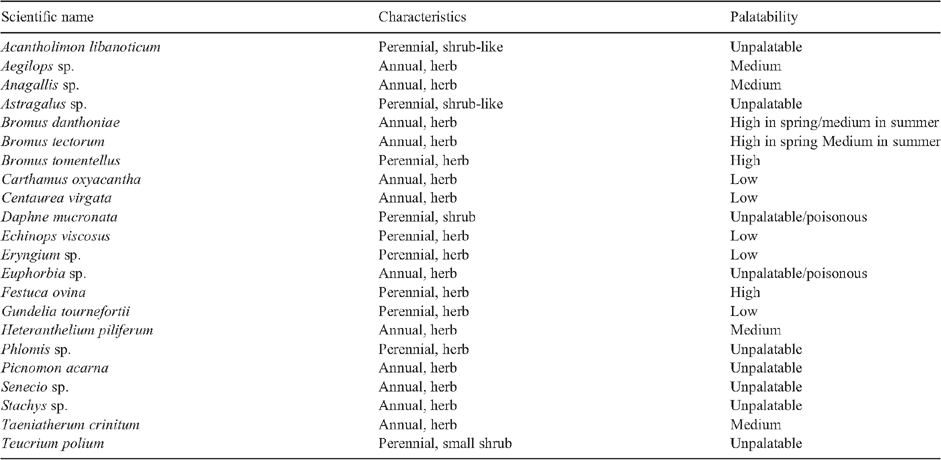Rangeland condition in relation to environmental variables, grazing intensity and livestock owners’ perceptions in semi-arid rangeland in western Iran
M. Faramarzi A B C , S. Kesting A , J. Isselstein A and N. Wrage AA Institute of Grassland Science, Department of Crop Sciences, University of Goettingen, Goettingen, Germany.
B Present address: Natural Resources Group, Faculty of Agricultural Sciences, Ilam University, Ilam, Iran.
C Corresponding author. Emails: faramarzi.marzban@gmail.com and mfarama@gwdg.de
The Rangeland Journal 32(4) 367-377 https://doi.org/10.1071/RJ09022
Submitted: 27 March 2009 Accepted: 19 July 2010 Published: 26 November 2010
Abstract
Rangeland condition has often been assessed in relation to either botanical, edaphic, environmental or management factors. In this investigation, we analysed the interaction of soil and topographic variables, management and range condition against the background of a sociological survey of livestock owners in western Iran to better understand the main influencing factors of rangeland quality in the area. In four grazing areas in Kermanshah differing in grazing pressure, environmental variables and livestock owners’ perceptions on range condition, investigations of botanical composition, soil and topographic variables were carried out on 43 main plots. To evaluate range condition, four factors were considered, namely litter frequency, herbage palatability, amount of biomass, and percentage of bare soil. A questionnaire was used to obtain information about management practices, the perception of livestock owners on range condition and suggested solutions to problems in the different grazing areas. The range condition scores showed that the condition of the sites was either fair or poor. Of the soil and topographic factors, only north-facing aspect explained part of the variation in range condition scores. High grazing intensity was associated with poor range condition. To improve the rangeland condition, measures influencing water availability and a reduction of grazing pressure seem to be more relevant in the study area than fertilisation or seeding.
Additional keywords: degradation, management, overgrazing, rangeland quality, soil and topographic variables.
Abule E.,
Snyman H. A., Smit G. N.
(2007) Rangeland evaluation in the middle Awash valley of Ethiopia: I. Herbaceous vegetation cover. Journal of Arid Environments 70, 253–271.
| Crossref | GoogleScholarGoogle Scholar |
(accessed 27 February 2010).
Bagheri H.,
Adnani M., Tavili A.
(2005) Studying the relationship between livestock and plant composition. Case study: semi steppic ranges of Vesf-Qom province. Pajouhesh-va-Sazandegi [In Persian, Abstract in English] 74, 155–162.
(accessed 29 Sept. 2010).
Farahpour M.,
van Keulen H.,
Sharifi M. A., Bassiri M.
(2004) A planning support system for rangeland allocation in Iran with case study of Chadegan sub-region. The Rangeland Journal 26, 225–236.
| Crossref | GoogleScholarGoogle Scholar |
(accessed 27 February 2010).
Klein J. A.,
Harte J., Zhao X.-Q.
(2007) Experimental warming, not grazing, decreases rangeland quality on the Tibetan plateau. Ecological Applications 17, 541–557.
| Crossref | GoogleScholarGoogle Scholar | PubMed |

Leriche H.,
Le Roux X.,
Desnoyers F.,
Benest D.,
Simioni G., Abbadie L.
(2003) Grass response to clipping in an African savanna: testing the grazing optimization hypothesis. Ecological Applications 13, 1346–1354.
| Crossref | GoogleScholarGoogle Scholar |

Marini L.,
Fontana P.,
Klimek S.,
Battisti A., Gaston K. J.
(2009) Impact of farm size and topography on plant and insect diversity of managed grasslands in the Alps. Biological Conservation 142, 394–403.
| Crossref | GoogleScholarGoogle Scholar |

Nael M.,
Khademi H., Hajabbasi M. A.
(2004) Response of soil quality indicators and their spatial variability to land degradation in central Iran. Applied Soil Ecology 27, 221–232.
| Crossref | GoogleScholarGoogle Scholar |

Read J. L.
(2002) Experimental trial of Australian arid zone reptiles as early warning indicators of overgrazing by cattle. Austral Ecology 27, 55–66.
| Crossref | GoogleScholarGoogle Scholar |

Rezaei S. A., Gilkes R. J.
(2005) The effects of landscape attributes and plant community on soil physical properties in rangelands. Geoderma 125, 145–154.
| Crossref | GoogleScholarGoogle Scholar |

Rezaei S. A.,
Gilkes R. J., Andrews S. S.
(2006) A minimum data set for assessing soil quality in rangelands. Geoderma 136, 229–234.
| Crossref | GoogleScholarGoogle Scholar |
CAS |

Riginos C., Hoffman M. T.
(2003) Changes in population biology of two succulent shrubs along a grazing gradient. Journal of Applied Ecology 40, 615–625.
| Crossref | GoogleScholarGoogle Scholar |

Safaian N., Shokri M.
(2003) A new approach to determine condition and capacity of rangelands for northern Iran. Iranian Journal of Natural Resources [In Persian, Abstract in English] 55, 597–606.

Searle K. R.,
Gordon I. J., Stokes C. J.
(2009) Hysteretic responses to grazing in a semiarid rangeland. Rangeland Ecology and Management 62, 136–144.
| Crossref | GoogleScholarGoogle Scholar |

Tefera S.,
Dlamini B. J.,
Dlamini A. M., Mlambo V.
(2008) Current range condition in relation to land management systems in semi-arid savannas of Swaziland. African Journal of Ecology 46, 158–167.
| Crossref | GoogleScholarGoogle Scholar |

Walkley A., Black I. A.
(1934) An examination of Degtjareff method for determining soil organic matter. Soil Science 37, 29–38.
| Crossref | GoogleScholarGoogle Scholar |
CAS |


|

|

|


